The Effect of a Manni Telescopic Herbst Appliance with Four Miniscrews (STM4) on the Treatment of a Class II Division I Malocclusion: A 3D Finite Element Study
Abstract
:1. Introduction
2. Materials and Methods
2.1. Imaging
2.2. Three-Dimensional Reconstruction and Model Preparation
2.3. Appliance Design
- ○
- The appliance comprises a maxillary fixed palatal arch connected by two telescoping rods to a mandibular acrylic splint. The rods permit forward mandibular movement along with a lower splint. The trans palatal arch is bonded onto the upper first molars. A second trans palatal arch, not connected to the first one, is placed onto two miniscrews inserted in the T-zone between the upper canine and the first upper premolar teeth. The upper TADs were titanium, with a length of 11 mm and a diameter of 2 mm (TAD for expanders, D2 L11 mm; Leone, Sesto Fiorentino, Italy). Bilateral elastic chains (Memory Chain, 150/200 g for each side; American Orthodontics, Sheboygan, Wis) connect the two palatal arches. The applied forces were derived from established biomechanical studies and validated clinical protocols to ensure physiologically relevant load distribution [10].
- ○
- In the mandible, auxiliary buttons were bonded on the buccal surface of the lower cuspids, and two 1.4 mm × 8 mm TADs (Osstem, Seoul, Republic of Korea) were placed bilaterally between the second premolar and first molar in the attached gingiva, with an insertion angle of about 45°. Elastic chains (Memory Chain, 150/200 g for each side; American Orthodontics, Sheboygan, Wis) were applied between the buttons and the lower miniscrews. The force provided by the elastic chains should be as parallel as possible to the occlusal plane (horizontal, depending on the bone availability). This protocol is defined as a Skeletal Therapy Manni Telescopic Herbst 4 TAD (STM4). Figure 2 shows the appliance design from a lateral perspective at baseline.
2.4. Boundary Conditions
- PDL with bone and PDL with tooth: a friction coefficient of 0.3 has been assigned to both interfaces to simulate the interaction between the periodontal ligament (PDL) with bone and tooth structures.
- Tooth with resin splint: similarly, a friction coefficient of 0.3 has been defined between the tooth and the resin splint to represent their interaction accurately.
- TAD (Temporary Anchorage Device) with bone: a fully bonded contact has been assumed between the TAD and bone, reflecting the osseointegration and stable anchorage typically observed in clinical scenarios.
- Cortical and cancellous bone interface: a fully bonded contact has been considered between cortical and cancellous bone layers, ensuring unified mechanical behavior under loading conditions.
- Titanium components: to accurately simulate their interaction, a friction coefficient of 0.12 has been defined between the titanium components.
2.5. Geometric Optimization in STL Format
2.6. Finite Element Model Development
- Titanium: elastic modulus of 113,000 MPa; Poisson’s ratio of 0.33.
- 316L stainless steel: elastic modulus of 200,000 MPa; Poisson’s ratio of 0.3.
- Bone and dental structures: the elastic moduli are set at 2000 MPa and 20,000 MPa, respectively, with a Poisson’s ratio of 0.3.
- Periodontal ligament (PDL): represented with an elastic modulus of 0.5 MPa and a Poisson’s ratio of 0.49 to simulate its biomechanical properties.
2.7. Mesh Generation and Boundary Conditions
2.8. Dynamic Simulation in CATIA
2.9. Finite Element Analysis and Evaluation of Results
3. Results
4. Discussion
4.1. Limitations
4.2. Future Directions
- Further research should incorporate multi-subject cohorts with diverse craniofacial morphologies.
- Advanced imaging techniques should be integrated to enable direct segmentation of the TMJ, articular disc, and associated soft tissues for greater anatomical precision.
- Prospective clinical studies are necessary to substantiate the biomechanical insights provided by this computational model.
4.3. Clinical Relevance
5. Conclusions
Author Contributions
Funding
Institutional Review Board Statement
Informed Consent Statement
Data Availability Statement
Conflicts of Interest
References
- Owayda, A.; Al-Sabbagh, R.; Farah, H.; Owayda, T.; Al-Ahmad, S. The effectiveness of the total-maxillary-arch-distalization approach in treating class II division 1 malocclusion: A systematic review. Clin. Oral Investig. 2024, 28, 333. [Google Scholar] [CrossRef] [PubMed]
- Almrayati, D.M.; Hajeer, M.Y.; Almusawi, A.O.A.; Jaber, S.T.; Baba, M.O.; Ajaj, M.A.; Ajaj Sr, M.A. Evaluation of the External Soft Tissue Changes Following the Correction of Class II Skeletal Malocclusion in the Adolescence Period Using Removable and Fixed Functional Appliances: A Systematic Review and Meta-Analysis. Cureus 2024, 16, e57070. [Google Scholar] [CrossRef] [PubMed]
- Habumugisha, J.; Cheng, B.; Ma, S.Y.; Zhao, M.Y.; Bu, W.Q.; Wang, G.L.; Liu, Q.; Zou, R.; Wang, F. A non-randomized concurrent controlled trial of myofunctional treatment in the mixed dentition children with functional mouth breathing assessed by cephalometric radiographs and study models. BMC Pediatr. 2022, 22, 506. [Google Scholar] [CrossRef]
- Nucera, R.; Lo Giudice, A.; Rustico, L.; Matarese, G.; Papadopoulos, M.A.; Cordasco, G. Effectiveness of orthodontic treatment with functional appliances on maxillary growth in the short term: A systematic review and meta-analysis. Am. J. Orthod. Dentofac. Orthop. 2016, 149, 600–611.e3. [Google Scholar] [CrossRef]
- Santori, F.; Masedu, F.; Ciavarella, D.; Staderini, E.; Chimenti, C.; Tepedino, M. Effect of Class II functional treatment on facial attractiveness, as perceived by professionals and laypeople. Sci. Rep. 2021, 11, 13989. [Google Scholar] [CrossRef]
- Staderini, E.; Ventura, V.; Meuli, S.; Maltagliati, L.Á.; Gallenzi, P. Analysis of the Changes in Occlusal Plane Inclination in a Class II Deep Bite “Teen” Patient Treated with Clear Aligners: A Case Report. Int. J. Environ. Res. Public Health 2022, 19, 651. [Google Scholar] [CrossRef]
- Pancherz, H. The Herbst appliance: Its biologic effects and clinical use. Am. J. Orthod. 1985, 87, 1–20. [Google Scholar] [CrossRef] [PubMed]
- Pancherz, H. Treatment of Class II malocclusions by jumping the bite with the Herbst appliance. A cephalometric investigation. Am. J. Orthod. 1979, 76, 423–442. [Google Scholar] [CrossRef]
- Pancher, Z.H.; Hansen, K. Mandibular anchorage in Herbst treatment. Eur. J. Orthod. 1988, 10, 149–164. [Google Scholar] [CrossRef]
- Manni, A.; Migliorati, M.; Boggio, A.; Drago, S.; Paggi, E.; Calzolari, C.; Gastaldi, G.; Cozzani, M. Evaluation of the Co–Go–Me angle as a predictor in Class II patients treated with Herbst appliance and skeletal anchorage: A retrospective cohort study. Front. Oral Health 2024, 5, 1389628. [Google Scholar] [CrossRef]
- Gotti, E.; Doldo, T.; Castellana, F.; Cozzani, M.; Manni, A.; Gastaldi, G.; Boggio, A. Mandibular Advancement and Skeletal Anchorage in Class II Malocclusion Patients: A Systematic Review with Meta-Analysis. Oral 2024, 4, 417–440. [Google Scholar] [CrossRef]
- Al-Dboush, R.; Soltan, R.; Rao, J.; El-Bialy, T. Skeletal and dental effects of Herbst appliance anchored with temporary anchorage devices: A systematic review with meta-analysis. Orthod. Craniofac. Res. 2022, 25, 31–48. [Google Scholar] [CrossRef]
- Huang, Y.; Sun, W.; Xiong, X.; Zhang, Z.; Liu, J.; Wang, J. Effects of fixed functional appliances with temporary anchorage devices on Class II malocclusion: A systematic review and meta analysis. J. World Fed. Orthod. 2021, 10, 59–69. [Google Scholar] [CrossRef]
- Neves, A.M.; Nascimento, M.; de Almeida Cardoso, M.; Meloti, F.; Silva, E.; An, T.L. Finite element analysis of a newly designed miniplate for orthodontic anchorage in the maxillary anterior region. Am. J. Orthod. Dentofac. Orthop. 2022, 162, 656–667. [Google Scholar] [CrossRef] [PubMed]
- Akis, H.; Doruk, C. Dentofacial Effects of Fixed Functional Appliances with or without Mini Screw Anchorage in the Treatment of Class II Division I Malocclusion: A Finite Element Analysis. Turk. J. Orthod. 2018, 31, 7–12. [Google Scholar] [CrossRef]
- Kumar, D.; Sharma, R.; Arora, V.; Bhupali, N.R.; Tuteja, N. Evaluation of displacements and stress changes in the maxillo-mandibular complex with fixed functional appliance skeletally anchored on mandible using miniplates: A finite element study. J. Orthod. Sci. 2022, 11, 42. [Google Scholar] [CrossRef]
- Zhang, M.; Liu, X.; Zhang, R.; Chen, X.; Song, Z.; Ma, Y.; Jin, Z. Biomechanical effects of functional clear aligners on the stomatognathic system in teens with class II malocclusion: A new model through finite element analysis. BMC Oral Health 2024, 24, 1313. [Google Scholar] [CrossRef] [PubMed]
- Wu, J.; Liu, Y.; Zhang, J.; Peng, W.; Jiang, X. Biomechanical investigation of orthodontic treatment planning based on orthodontic force measurement and finite element method before implementation: A case study. Technol. Health Care 2018, 26, 347–359. [Google Scholar] [CrossRef]
- Mascarenhas, R.; Parveen, S.; Shenoy, B.S.; Kumar, G.S.; Ramaiah, V.V. Infinite applications of finite element method. J. Indian Orthod. Soc. 2018, 52, 142–150. [Google Scholar] [CrossRef]
- Sugii, M.M.; Barreto, B.C.F.; Francisco Vieira Júnior, W.; Simone, K.R.I.; Bacchi, A.; Caldas, R.A. Extruded upper first molar intrusion: Comparison between unilateral and bilateral miniscrew anchorage. Dental Press J. Orthod. 2018, 23, 63–70. [Google Scholar] [CrossRef]
- Kushwah, A.; Kumar, M.; Goyal, M.; Premsagar, S.; Rani, S.; Sharma, S. Analysis of stress distribution in lingual orthodontics system for effective en masse retraction using various combinations of lever arm and mini implants: A finite element method study. Am. J. Orthod. Dentofac. Orthop. 2020, 158, e161–e172. [Google Scholar] [CrossRef]
- Cattaneo, P.M.; Cornelis, M.A. Orthodontic tooth movement studied by finite element analysis: An update. What can we learn from these simulations? Curr. Osteoporos. Rep. 2021, 19, 175–181. [Google Scholar] [CrossRef] [PubMed]
- Scarano, A.; Lorusso, F.; Santos de Oliveira, P.; Kunjalukkal Padmanabhan, S.; Licciulli, A. Hydroxyapatite block produced by sponge replica method: Mechanical, clinical and histologic observations. Materials 2019, 12, 3079. [Google Scholar] [CrossRef] [PubMed]
- Torsello, F.; D’Amico, G.; Staderini, E.; Marigo, L.; Cordaro, M.; Castagnola, R. Factors Influencing Appliance Wearing Time during Orthodontic Treatments: A Literature Review. Appl. Sci. 2022, 12, 7807. [Google Scholar] [CrossRef]
- Pancherz, H. The mechanism of Class II correction in Herbst appliance treatment. A cephalometric investigation. Am. J. Orthod. 1982, 82, 104–113. [Google Scholar] [CrossRef]
- Showkatbakhsh, R.; Castaldo, M.I.; Jamilian, A.; Padricelli, G.; Cappabianca, S.; Perillo, L. Treatment effects of R-appliance and Frankel-2 in Class II division 1 malocclusions. Eur. J. Paediatr. Dent. 2013, 14, 17–22. [Google Scholar]
- Manni, A.; Boggio, A.; Castellana, F.; Gastaldi, G.; Cozzani, M. Mandibular Advancement after Pubertal Peak with Acrylic Splint Herbst Appliance Anchored to Four Miniscrews: A Retrospective Controlled Study. Oral 2024, 4, 449–458. [Google Scholar] [CrossRef]
- Zhu, C.; Li, R.; Yuan, L.; Zheng, Y.; Jin, Y.; Li, H.; Liu, C.; Xia, L.; Fang, B. Effects of the advanced mandibular spring on mandibular retrognathia treatment: A three-dimensional finite element study. BMC Oral Health 2022, 22, 271. [Google Scholar] [CrossRef]
- Duggal, I.; Sidhu, M.S.; Chawla, A.; Dabas, A.; Dhimole, V.K. Effects of miniplate anchored Herbst appliance on skeletal, dental and masticatory structures of the craniomandibular apparatus: A finite element study. Int. Orthod. 2021, 19, 301–309. [Google Scholar] [CrossRef]

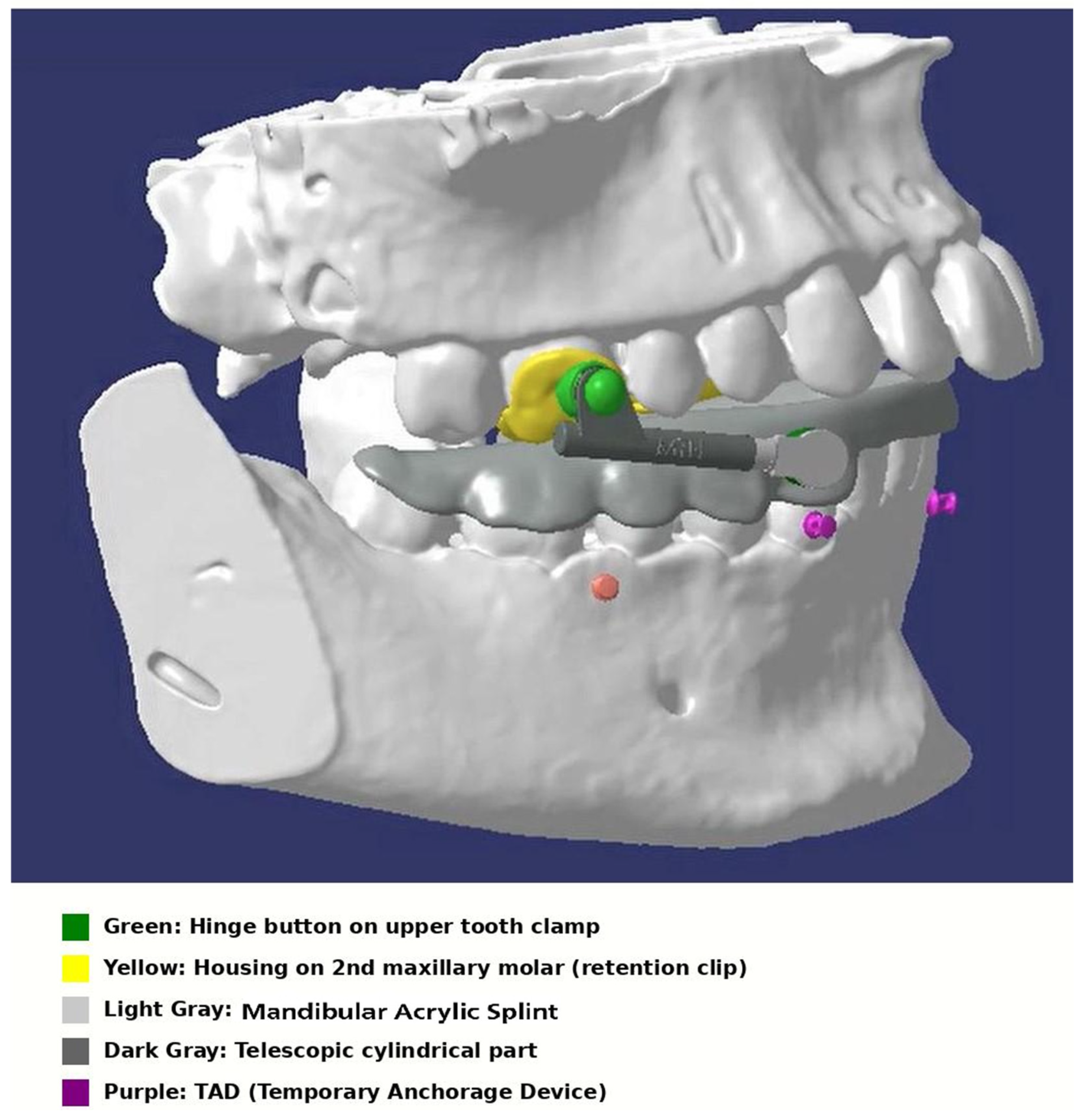
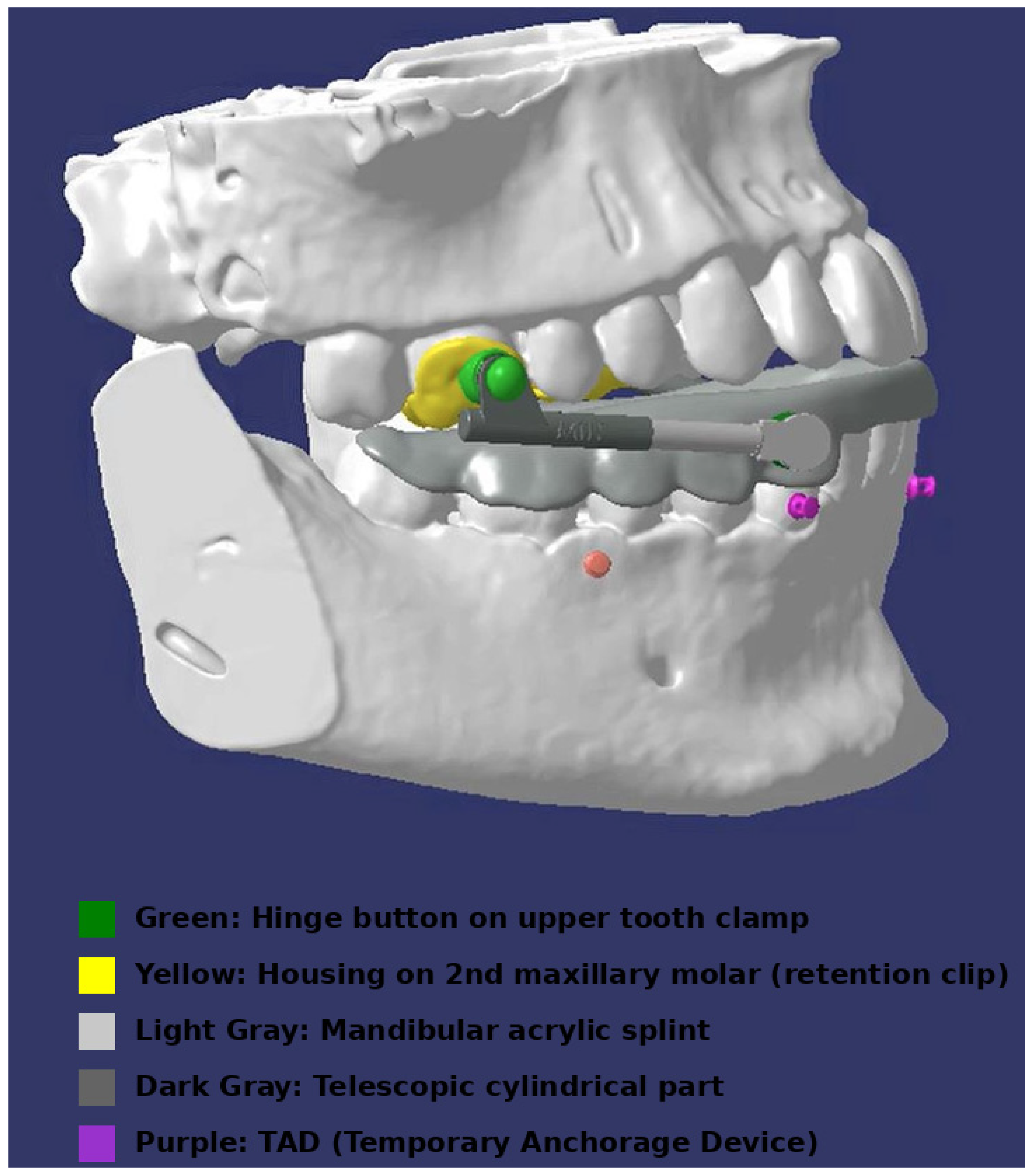
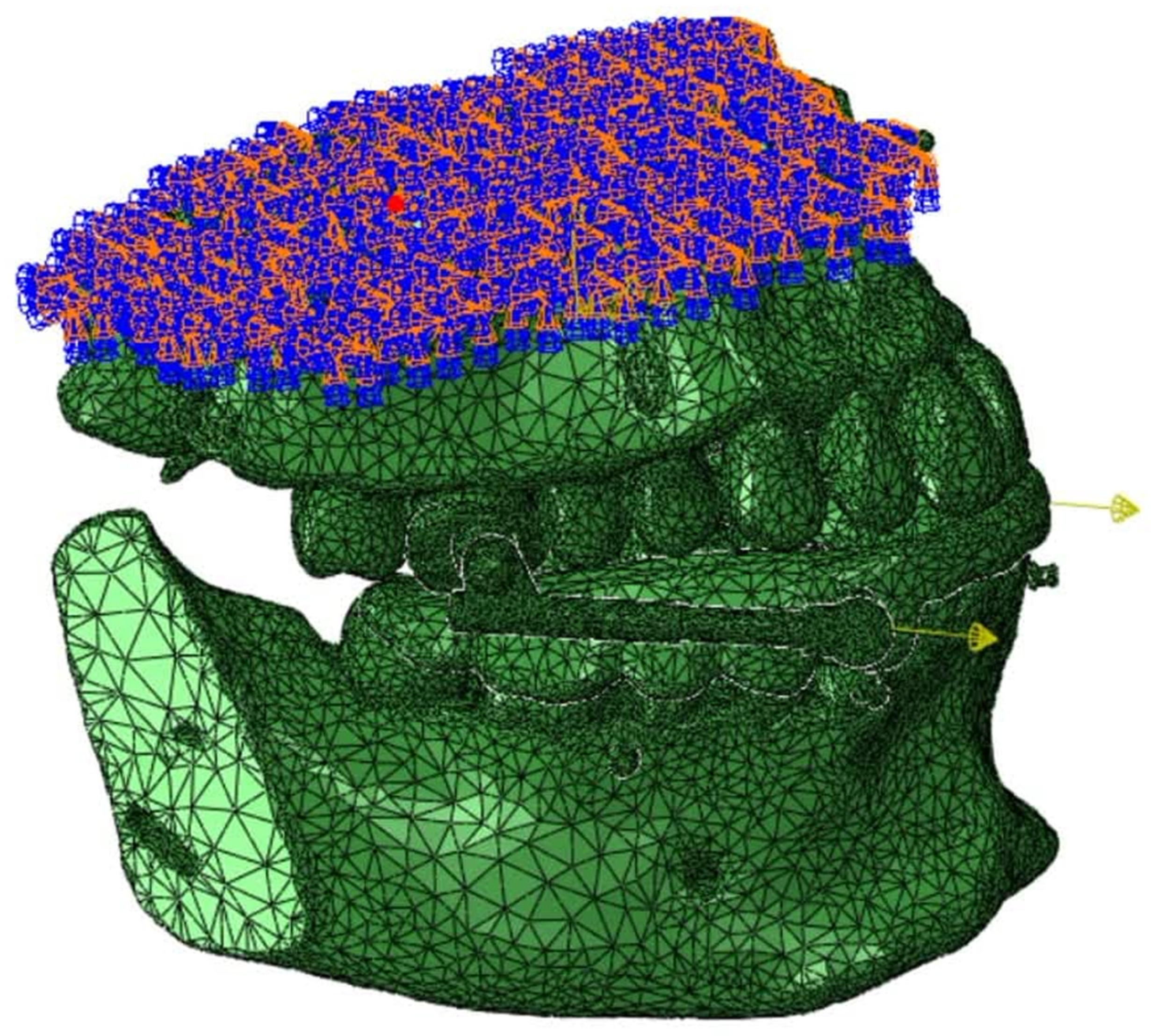

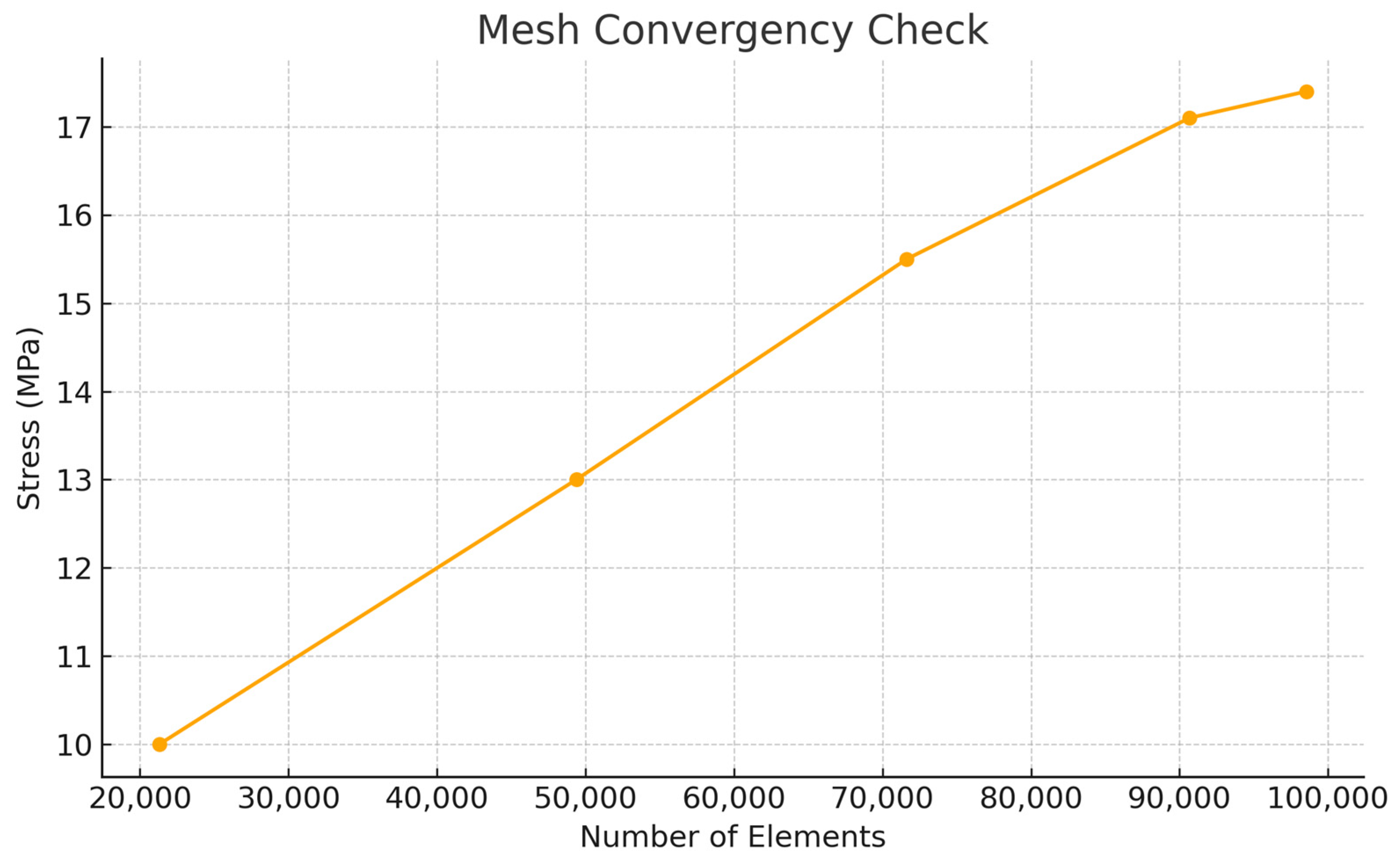
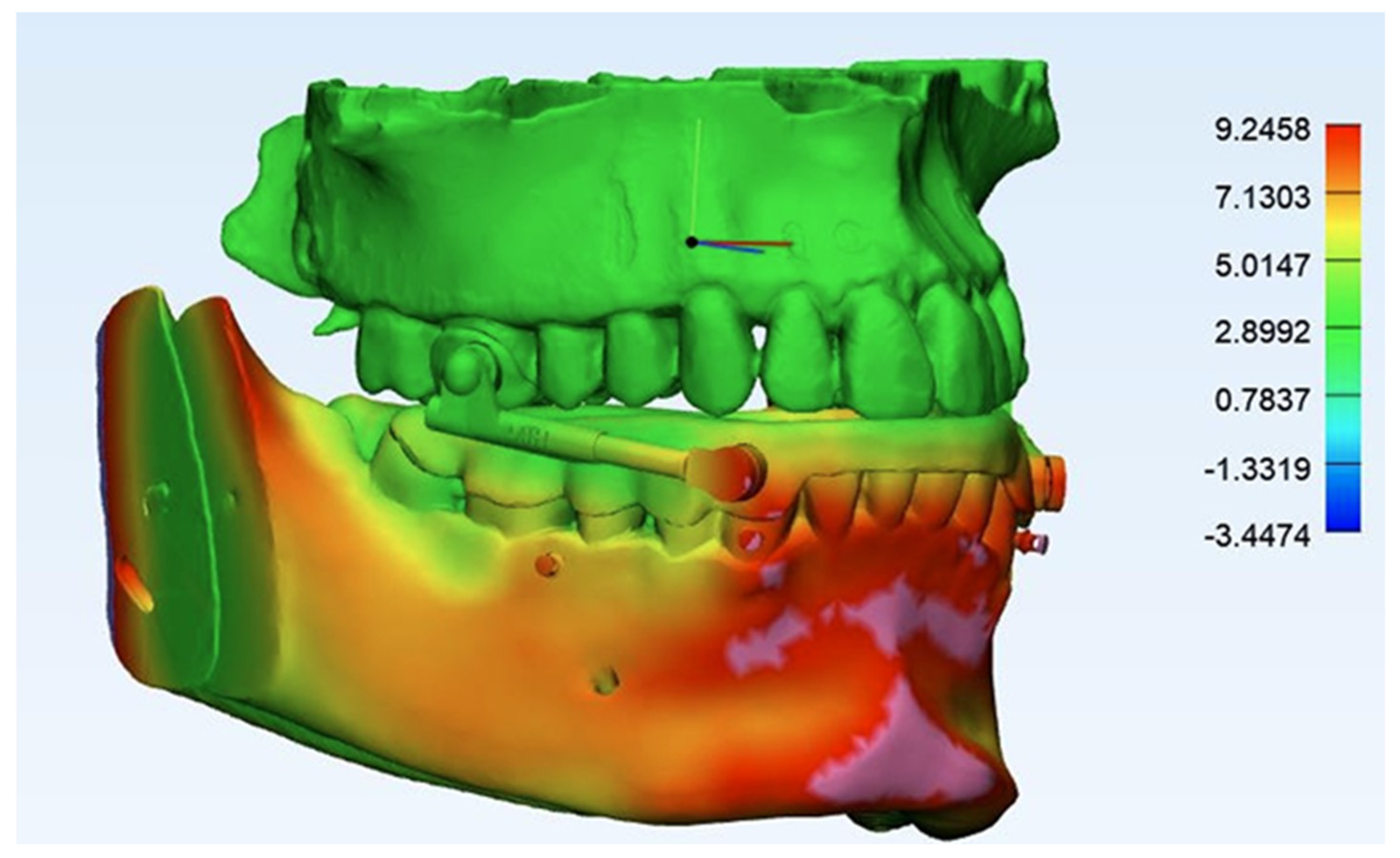
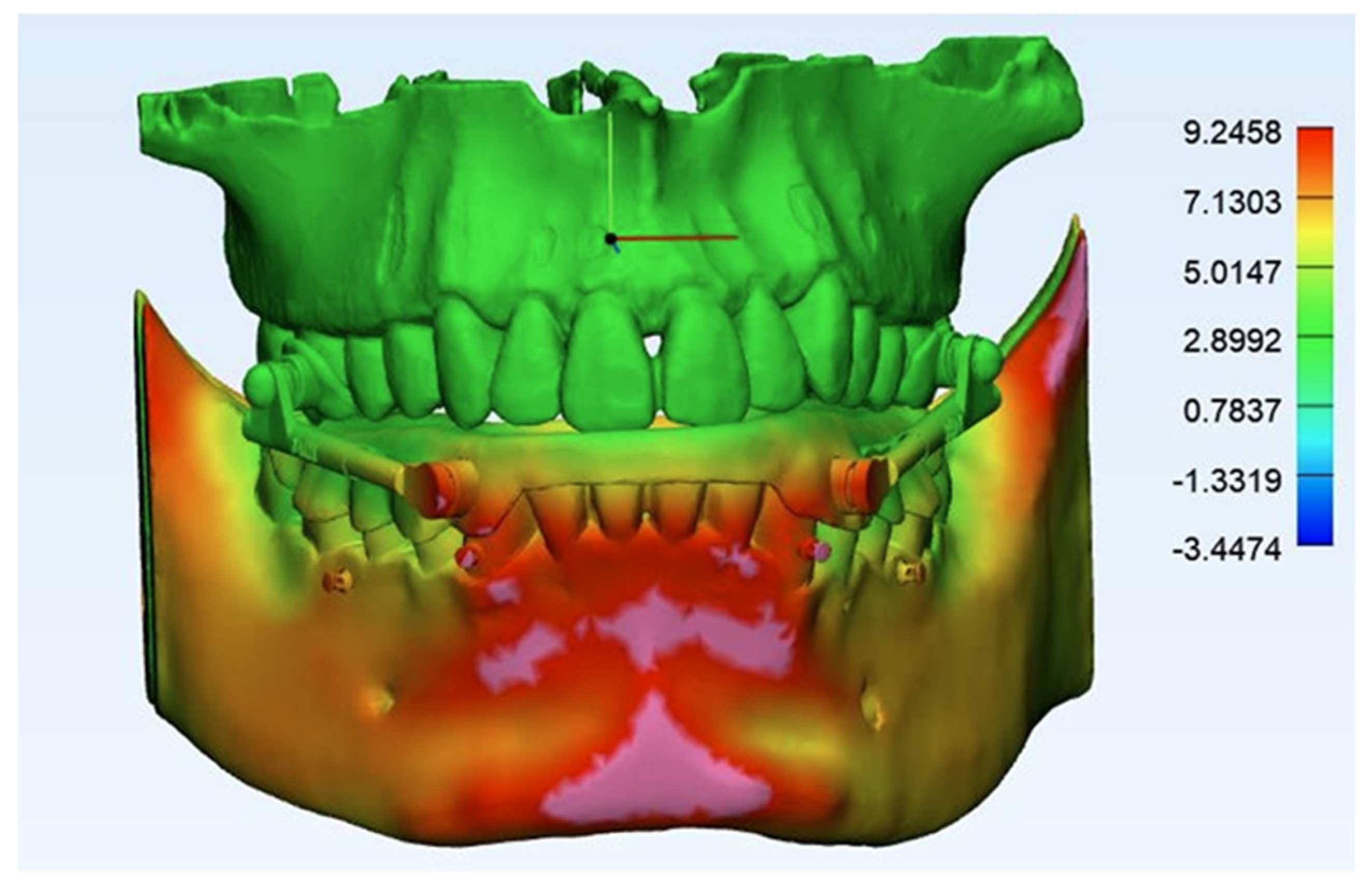
| Material | Elastic Modulus (MPa) | Poisson’s Ratio | Reference |
|---|---|---|---|
| Titanium | 113,000 | 0.33 | [3] |
| 316L stainless steel | 200,000 | 0.3 | [1,2] |
| Bone | 2000 | 0.3 | [1,2] |
| Tooth | 20,000 | 0.3 | [1,2] |
| Periodontal ligament (PDL) | 0.5 | 0.49 | [1,2] |
| Component | Number of Elements | Number of Nodes | Type of Element |
|---|---|---|---|
| Teeth | 53,704 | 141,630 | Tetrahedral C3D4 |
| Miniscrews | 16,307 | 45,659 | Tetrahedral C3D4 |
| Mandible | 98,537 | 261,987 | Tetrahedral C3D4 |
| Maxilla | 79,618 | 206,193 | Tetrahedral C3D4 |
| PDL | 8370 | 24,188 | Tetrahedral C3D4 |
| Splint | 13,907 | 39,052 | Tetrahedral C3D4 |
| SS 316L | 12,706 | 36,212 | Tetrahedral C3D4 |
| X Displacement | Y Displacement | Z Displacement | |
|---|---|---|---|
| Pogonion | 0 | −0.52 | 10.11 |
| Menton | 0 | −0.67 | 8.25 |
| A | 0 | −0.04 | −0.22 |
| B | 0 | −0.32 | 10.18 |
| Incisal Edge/Occlusal | Apical | |||||
|---|---|---|---|---|---|---|
| X Displacement | Y Displacement | Z Displacement | X Displacement | Y Displacement | Z Displacement | |
| Central incisor | 0.012516 | 0.086041 | −0.416935 | −0.000444 | 0.017823 | −0.054445 |
| Lateral incisor | −0.022780 | 0.119059 | −0.457540 | 0.000187 | 0.009773 | −0.050505 |
| Canine | −0.015069 | 0.143825 | −0.471170 | 0.000303 | 0.011076 | −0.075545 |
| First premolar | −0.012634 | 0.065466 | 0.659029 | 0.000103 | 0.013930 | 0.059213 |
| Second premolar | 0.009862 | 0.177320 | 0.554165 | 0.000390 | 0.009061 | 0.030745 |
| First molar | 0.006544 | 0.078013 | 0.212875 | −0.001413 | 0.006485 | 0.044349 |
| Second molar | −0.001394 | 0.154285 | 0.461081 | 0.001402 | 0.013069 | 0.036939 |
| Incisal Edge/Occlusal | Apical | |||||
|---|---|---|---|---|---|---|
| X Displacement | Y Displacement | Z Displacement | X Displacement | Y Displacement | Z Displacement | |
| Central incisor | 0.001952 | −0.012080 | −0.051145 | −0.001623 | 0.023435 | 0.073035 |
| Lateral incisor | −0.002819 | −0.017835 | −0.065240 | 0.000991 | 0.002900 | 0.059653 |
| Canine | 0.001726 | −0.012340 | −0.084375 | −0.000114 | 0.015689 | 0.055951 |
| First premolar | 0.002972 | −0.015370 | 0.030957 | 0.000086 | 0.001712 | −0.073715 |
| Second premolar | 0.002888 | −0.016625 | 0.062654 | −0.000579 | 0.008996 | −0.063850 |
| First molar | 0.002126 | −0.015065 | 0.032363 | 0.001781 | 0.017695 | −0.051695 |
| Second molar | −0.001768 | −0.013635 | 0.068918 | 0.002304 | 0.007594 | −0.064980 |
Disclaimer/Publisher’s Note: The statements, opinions and data contained in all publications are solely those of the individual author(s) and contributor(s) and not of MDPI and/or the editor(s). MDPI and/or the editor(s) disclaim responsibility for any injury to people or property resulting from any ideas, methods, instructions or products referred to in the content. |
© 2025 by the authors. Licensee MDPI, Basel, Switzerland. This article is an open access article distributed under the terms and conditions of the Creative Commons Attribution (CC BY) license (https://creativecommons.org/licenses/by/4.0/).
Share and Cite
Boggio, A.; Jamilian, A.; Manni, A.; Gastaldi, G.; Farjaminejad, R.; Hasani, M.; Cozzani, M. The Effect of a Manni Telescopic Herbst Appliance with Four Miniscrews (STM4) on the Treatment of a Class II Division I Malocclusion: A 3D Finite Element Study. Oral 2025, 5, 27. https://doi.org/10.3390/oral5020027
Boggio A, Jamilian A, Manni A, Gastaldi G, Farjaminejad R, Hasani M, Cozzani M. The Effect of a Manni Telescopic Herbst Appliance with Four Miniscrews (STM4) on the Treatment of a Class II Division I Malocclusion: A 3D Finite Element Study. Oral. 2025; 5(2):27. https://doi.org/10.3390/oral5020027
Chicago/Turabian StyleBoggio, Andrea, Abdolreza Jamilian, Antonio Manni, Giorgio Gastaldi, Rosana Farjaminejad, Mojtaba Hasani, and Mauro Cozzani. 2025. "The Effect of a Manni Telescopic Herbst Appliance with Four Miniscrews (STM4) on the Treatment of a Class II Division I Malocclusion: A 3D Finite Element Study" Oral 5, no. 2: 27. https://doi.org/10.3390/oral5020027
APA StyleBoggio, A., Jamilian, A., Manni, A., Gastaldi, G., Farjaminejad, R., Hasani, M., & Cozzani, M. (2025). The Effect of a Manni Telescopic Herbst Appliance with Four Miniscrews (STM4) on the Treatment of a Class II Division I Malocclusion: A 3D Finite Element Study. Oral, 5(2), 27. https://doi.org/10.3390/oral5020027







